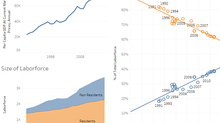Precision Warfare: Choosing the Right Tool for Your Data Battles – NumPy, Excel, or SPSS?

Photo by Ricardo Arce on Unsplash
In the bustling world of data analysis, the right tool can be the difference between insightful revelations and missed opportunities. Imagine you're working on a crucial project, whether it's predicting market trends, conducting groundbreaking research, or crafting the next big financial model. Accuracy and efficiency are your best friends, but which tool should you trust? NumPy, Excel, or SPSS? Let’s dive into this data duel and find out!
The Problem: Accuracy in Data Computation
Every data analyst, scientist, and engineer knows the pain of dealing with inaccurate computations. Picture this: you’ve spent days crunching numbers for a market analysis, only to find out that minor errors have thrown off your entire model. Frustrating, right? With so many tools at our disposal, how do we ensure we pick the one that guarantees precision and reliability?
Meet the Contenders
NumPy: Think of NumPy as the Swiss Army knife for scientific computing in Python. It’s your go-to for handling arrays, matrices, and complex mathematical functions. Whether you're a data scientist working on machine learning models or an engineer solving intricate equations, NumPy is your trusty sidekick. Fun fact: NumPy powers sophisticated AI systems like ChatGPT!
Excel: Ah, Excel. The beloved spreadsheet software that’s as ubiquitous in offices as coffee. It's perfect for data entry, quick calculations, and even some pretty neat visualizations. Excel is like the friendly neighborhood tool that everyone knows and loves, but does it have the muscle for heavy-duty tasks?
SPSS: Enter SPSS, the powerhouse of statistical analysis. If you’re deep into social sciences, market research, or health studies, SPSS is your tool. It’s packed with comprehensive statistical tools that make complex data analysis a breeze, but how does it compare to its peers in other areas?
Precision and Accuracy
Imagine you're calculating the trajectory of a spacecraft. Precision is non-negotiable.
NumPy: Uses double-precision floating-point format (64 bits). It’s like having a high-powered telescope—every detail counts.
Excel: Also uses double-precision, but sometimes it’s like using a pair of binoculars; great for general use, but not always perfect for pinpoint accuracy.
SPSS: Also precise with double-precision, but its real strength lies in statistical computation, like using a specialized scientific instrument.
Rounding Errors
Ever tried to balance your checkbook to the penny?
NumPy: Offers extensive control over rounding, minimizing errors. It’s like having a precise accountant.
Excel: Built-in rounding can sometimes introduce small errors. Think of it as your trusty but occasionally forgetful bookkeeper.
SPSS: Adheres to statistical standards for rounding, generally reliable like a seasoned statistician.
Consistency and Reproducibility
Let’s say you need to replicate a groundbreaking study.
NumPy: Consistent results, making it perfect for scientific research.
Excel: Generally consistent, but large datasets can be a challenge.
SPSS: Highly consistent for statistical analysis, the gold standard for reproducibility.
Performance and Scalability
Imagine analyzing terabytes of data from a social media platform.
NumPy: Optimized for large datasets. It’s like driving a sports car on a race track.
Excel: Best for small to medium datasets. Great for city driving, but struggles on the autobahn.
SPSS: Handles large datasets efficiently, like a heavy-duty truck on a long haul.
Usability and Flexibility
Complexity Sequence:
Excel: Least complex, user-friendly. Like riding a bicycle—easy to pick up and use.
SPSS: More complex but user-friendly for statistical tasks. Think of it as driving an SUV—more features, but still easy.
NumPy: Most complex, requires programming knowledge. It’s like flying a plane—requires training, but offers unmatched control and flexibility.
Error Handling and Debugging
NumPy: Detailed error messages. It’s like having a built-in diagnostic tool.
Excel: Error messages can be vague, like a mysterious engine light.
SPSS: Clear error messages, robust tools, like a mechanic’s toolkit.
Pricing
NumPy: Free and open-source. It’s like getting a high-end gadget for free.
Excel: Requires a Microsoft Office license. Think of it as a subscription service.
SPSS: Expensive, aimed at professionals. It’s like investing in a specialized, high-end machine.

The Solution: Choosing the Right Tool
High precision and complex calculations? Go with NumPy.
Quick calculations and ease of use? Excel is your friend.
In-depth statistical analysis? SPSS is the way to go.
Conclusion
In the quest for data supremacy, NumPy, Excel, and SPSS each bring something unique to the table. NumPy offers high precision and performance, Excel wins on ease of use and accessibility, and SPSS excels in statistical analysis. Your choice should be guided by your task’s needs and your comfort with these tools. By understanding their strengths, limitations, and costs, you can make an informed decision that ensures your data analysis is both accurate and efficient.


























Comments